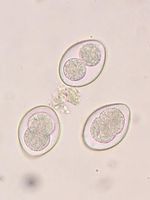Difference between revisions of "Coccidia Life Cycle"
Fiorecastro (talk | contribs) |
|||
| (6 intermediate revisions by one other user not shown) | |||
| Line 1: | Line 1: | ||
| − | {{ | + | {{review}} |
[[Image:Coccidia_logo.jpg|thumb|right|150px|''Coccidia'' <br> Joel Mills, WikiMedia Commons]] | [[Image:Coccidia_logo.jpg|thumb|right|150px|''Coccidia'' <br> Joel Mills, WikiMedia Commons]] | ||
| Line 13: | Line 13: | ||
The released merozoites then infect new intestinal cells and differentiate into '''gametocytes'''. The females, known as '''macrogametocytes''' are large single nuclear cells, they increase in size to fill the host cell. Merozoites that develop into the male gametocyte, or '''microgametocyte''', divide into a large number of small cells with flagella. The motile microgametocytes are released from the parasitised cell as it ruptures. A single microgametocyte will penetrate a macrogametocyte and the nuclei of both cells will fuse. A wall then develops around the new '''oocyst''' which then remains in this stage of development until released from the body in the hosts faeces. Sporogony will then begin as described above. | The released merozoites then infect new intestinal cells and differentiate into '''gametocytes'''. The females, known as '''macrogametocytes''' are large single nuclear cells, they increase in size to fill the host cell. Merozoites that develop into the male gametocyte, or '''microgametocyte''', divide into a large number of small cells with flagella. The motile microgametocytes are released from the parasitised cell as it ruptures. A single microgametocyte will penetrate a macrogametocyte and the nuclei of both cells will fuse. A wall then develops around the new '''oocyst''' which then remains in this stage of development until released from the body in the hosts faeces. Sporogony will then begin as described above. | ||
| − | + | [[Category:Coccidia]] | |
| − | + | [[Category:To_Do_-_NickJ]] | |
| − | |||
| − | |||
| − | |||
| − | |||
| − | |||
| − | |||
| − | |||
| − | |||
| − | [[Category: | ||
| − | |||
[[Category:Expert_Review]] | [[Category:Expert_Review]] | ||
Revision as of 17:31, 21 July 2010
| This article has been peer reviewed but is awaiting expert review. If you would like to help with this, please see more information about expert reviewing. |
Coccidia belong to the phylum Apicomplexa and are protozoan parasites of mammals, birds and reptiles. Coccidia have three major stages to their life cycle: Sporogony, Schizogony, Gametogony. The first two stages are asexual, with sexual reproduction occurring in the third stage. The following is a general life cycle though there is some variation in the various suborders.
Sporogony/Sporulation
Thick shelled oocysts are passed unsporulated in the feaces of the host, these consist of a single nucleus in a large pool of protoplasm. Sporulation occurs when conditions in the environment are suitable; high humidity, good oxygenation, and temperatures around 270C. The nucleus will divide a number of times depending on the species of coccidia and the number of sporocysts it will form also depends on the species. After division of the nucleus the protoplasm will form conical bodies around each nucleus budding off from the central core. The nucleus and conical body together will then form a sporoblast. The sporoblast will creates a wall for itself by secreting materials, at the same time the protoplasm forms two sporozoites within the sporocyst wall. This process can take between 2 and 4 hours under optimal conditions but may take considerably longer if conditions are not suitable.
Merogony/Schizogony
Once the sporozoites have been formed, the oocyst is an infective sporulated oocyst that is ingested by the host for the life cycle to continue. The remaining stages of the life cycle occur endogenously within the host. The ingested sporozoites are released from the oocyst and activated by trypsin or bile before invading intestinal epithelial cells. When the sporozoites have invaded an epithelial cell they become rounded and are called trophozoites. This trophozoite will then divide into a number of elongated nucleated merozoites, collectively known as a meront. Once the meront has grown and matured sufficiently it ruptures along with the epithelial cell, freeing the merozoites to either infect another epithelial cell and repeat the progress or progress on to sexual reproduction.
Gametogony
The released merozoites then infect new intestinal cells and differentiate into gametocytes. The females, known as macrogametocytes are large single nuclear cells, they increase in size to fill the host cell. Merozoites that develop into the male gametocyte, or microgametocyte, divide into a large number of small cells with flagella. The motile microgametocytes are released from the parasitised cell as it ruptures. A single microgametocyte will penetrate a macrogametocyte and the nuclei of both cells will fuse. A wall then develops around the new oocyst which then remains in this stage of development until released from the body in the hosts faeces. Sporogony will then begin as described above.
